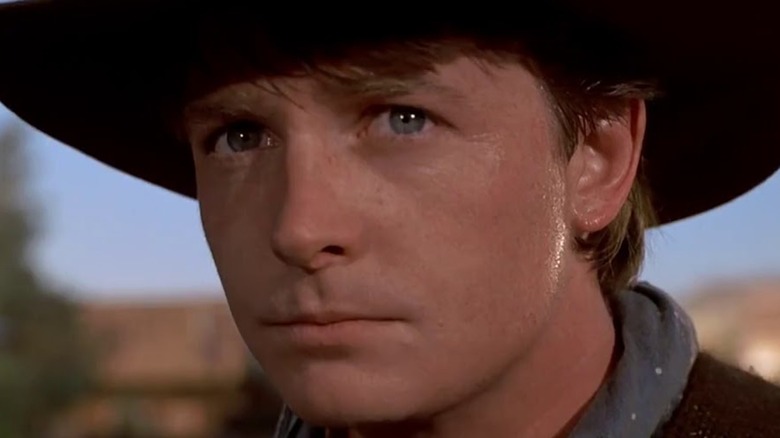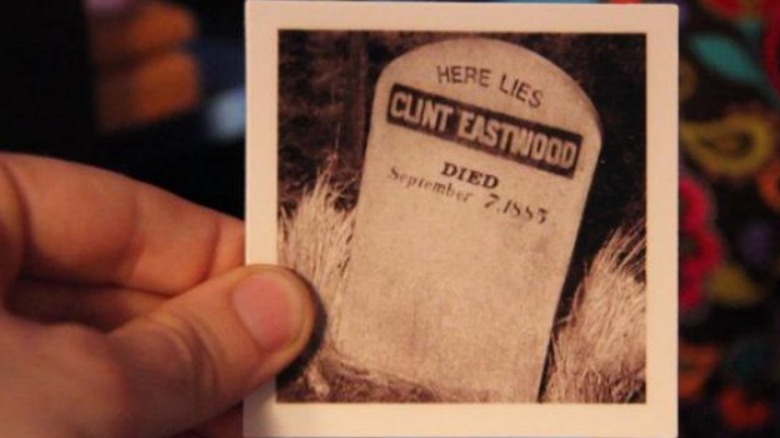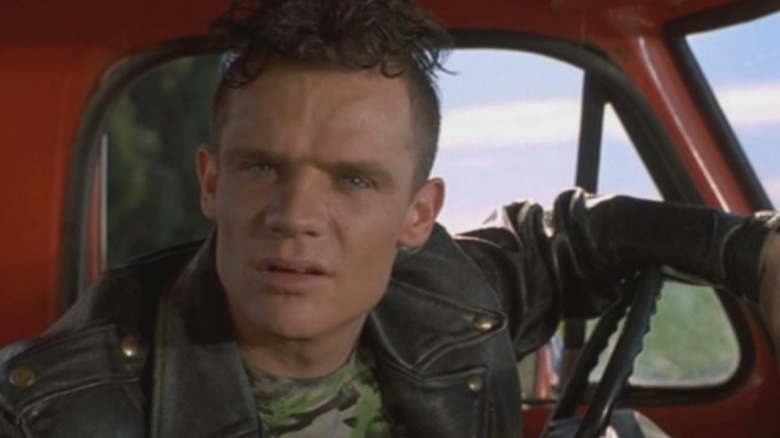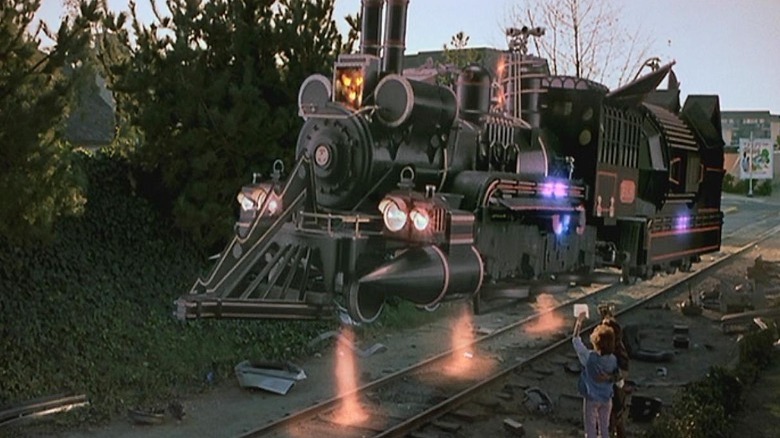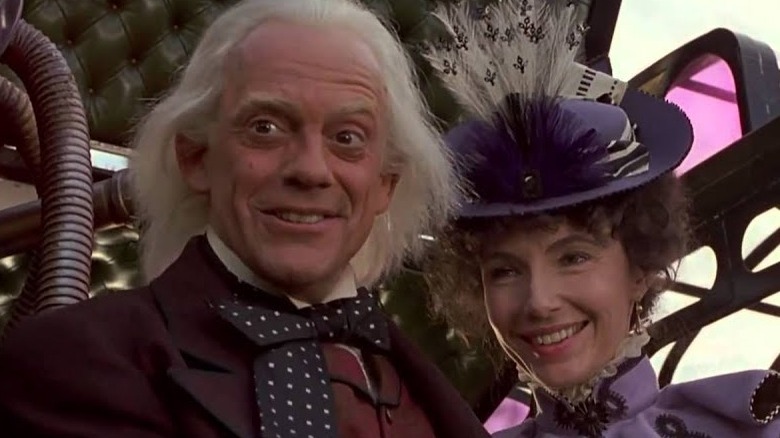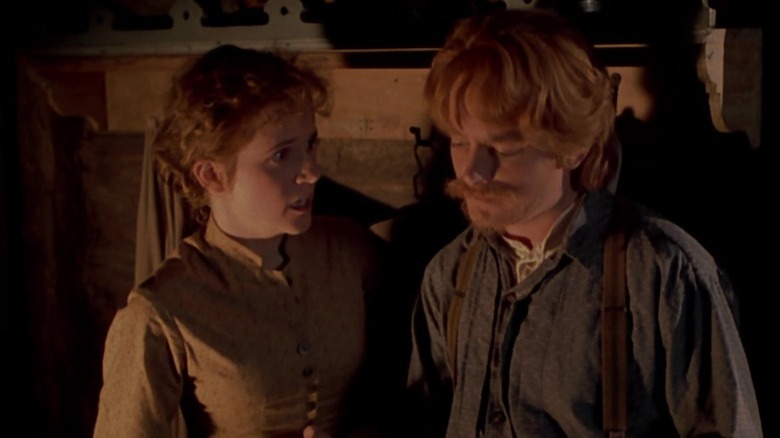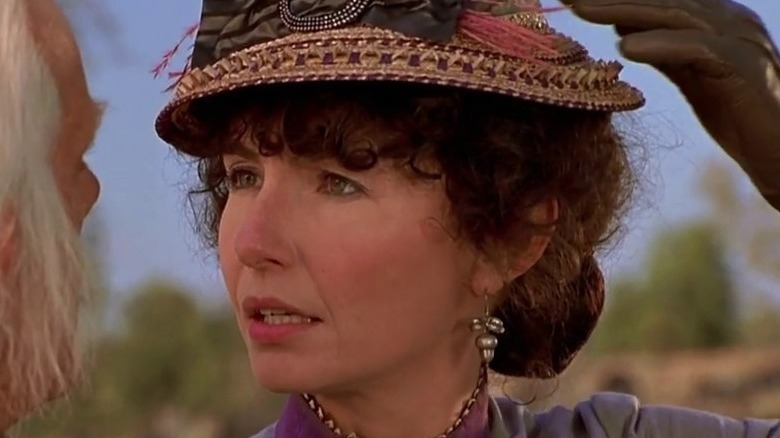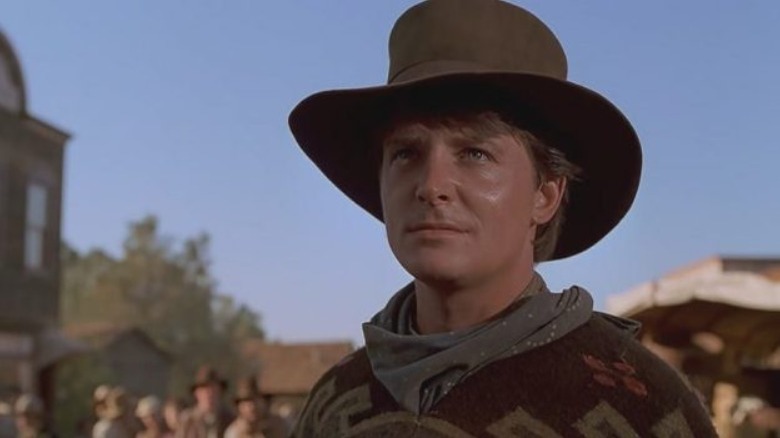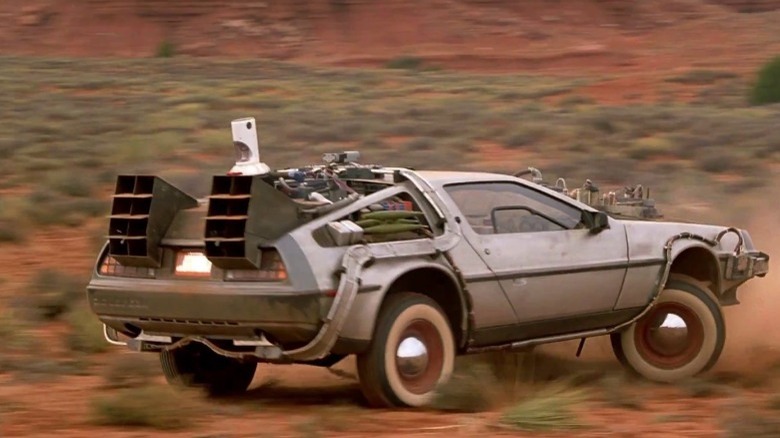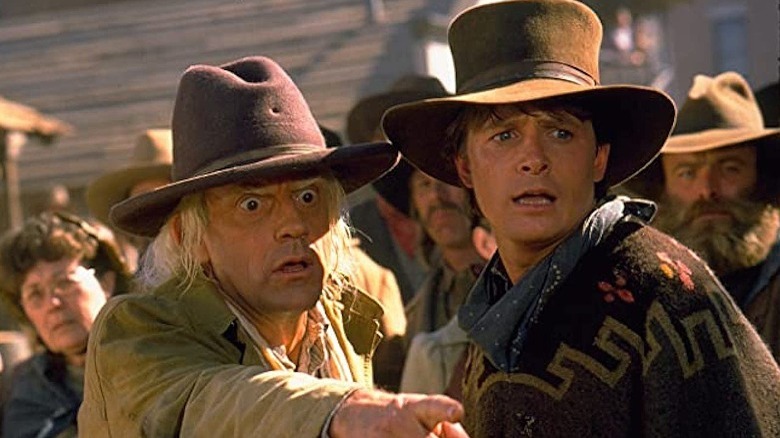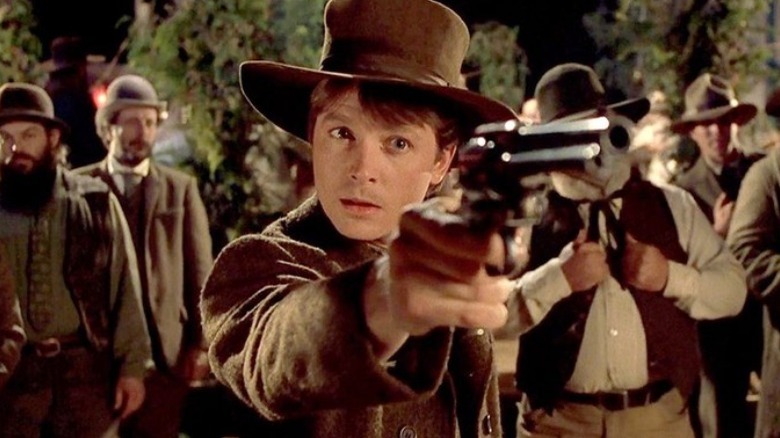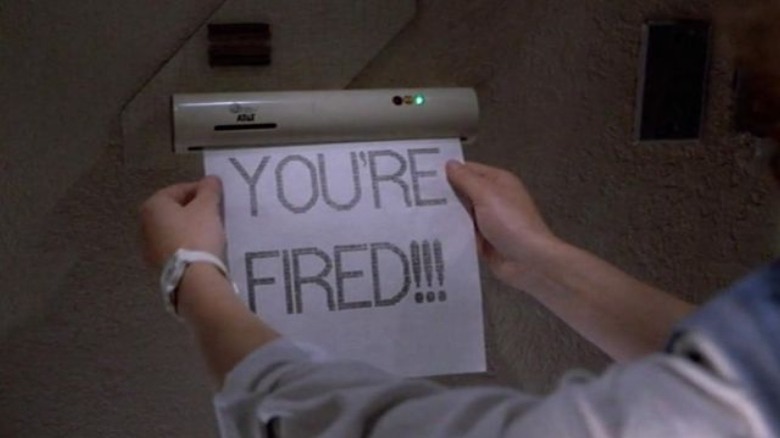The Ending Of Back To The Future Part III Explained
The "Back to the Future" franchise is one of cinema's most legendary, but as a trilogy it is subject to diminishing returns. The first movie is widely regarded as one of the best, if not the best sci fi movie of all time. "Back to the Future Part II" stands out as the most unique film of the trilogy, since it's the only one that visits the "future" (relative to 1985) in its fantastic and imaginative sequences set in 2015. But the third installment, even though it was filmed back-to-back with "Part II" and pays off many cliffhangers from the ending, is by far the less heralded of the trilogy as it strands Marty and Doc Brown in the distant past of 1885.
But even though "Back to the Future Part III" doesn't have the appeal of the original's '50s nostalgia or the second entry's future technology, it still has the kind of fun with stunt casting and madcap action sequences that the "Back to the Future" franchise is known for, and brings the story to a satisfying close. Since "Back to the Future" remains one of the biggest movie franchises that has never been extended or rebooted, and it appears likely to remain that way, the third and final movie is worth dusting off to explore the ways it stands on its own, and the ways it concludes the story of Doc and Marty's time-displaced friendship. This is the ending of "Back to the Future Part III," explained.
The future is unwritten, except when it's photographed
Much like the first movie, "Back to the Future Part III" has a key photograph that helps Doc and Marty check whether events are unfolding the right way. In this case, it's the photograph that Marty snapped of Doc's future gravestone, which helpfully spells out the exact date and manner of his death, even down to the eighty dollar amount that Buford Tannen claimed Doc owed him. Initially, after Marty goes back to 1885 to save Doc and they plan to leave that morning instead, the gravestone has turned blank in the photo.
The logistics of how photographs can track timeline changes in the "Back to the Future" universe aren't entirely clear: why would someone put up a blank gravestone and leave it there for 70 years? But soon it says "Clint Eastwood" instead of "Emmet Brown," implying that Marty is going to get killed by Tannen instead, and his fake name will be recorded in eternity. It's only when Marty finally gets the better of Tannen (by using a trick from a Clint Eastwood movie) that the gravestone in the photo disappears entirely, as nobody got killed (and it got accidentally broken in half anyway).
The car accident and the disappearing printout
If you weren't old enough to see "Back to the Future Part III" in the theaters, it's possible you watched it on video well more than a year after you saw "Part II," so you might have forgotten there are a few dangling plot elements from the second movie that aren't resolved until the end of the third. Marty's journey to self-awareness, where he realizes that he doesn't have to be goaded into fighting every time a bully calls him "chicken" or "a baby" or what have you, is the only real bit of character development in the whole trilogy, which is otherwise just adventure-centric.
After realizing with Buford Tannen that it's not important what anyone else thinks, Marty applies the same lesson when challenged to a drag race at a stoplight by his excitable high school classmate Needles. This is the "accident in the future" that Doc had mentioned earlier in "Part III"— in "Part II" it's mentioned that Marty hits a Rolls Royce as a result of this moment, causing him to injure his hand and give up on music. After his experiences in the future and past, Marty reverses instead of racing, and sees the Rolls Royce pass harmlessly by. As it rewrites the entire future, the note that Jennifer took back from 2015 saying "YOU'RE FIRED!!!" (which Needles was also indirectly responsible for) fades to blank.
Destroy the time machine (or build a new one?)
"Back to the Future Part III" comes close to making some sort of statement about the moral implications of time travel, only to back off at the very end. Doc's instructions to Marty, in the letter at the beginning of the movie, are to return to 1985 with the DeLorean and destroy it. Marty defies these wishes when he sees Doc will be murdered in 1885, and goes back to save him, but Doc still insists that after they both return to the present, the time machine must be destroyed.
After the plan with the train is successful and Marty returns to his original time alone, this is accomplished promptly by another train on the tracks, which demolishes the DeLorean almost instantly. Doc, it seems for a moment, is trapped in the past, but at least he's in love and no one will ever mess with the timeline again. However, Doc shows up not long afterwards in a completely new time machine made from a flying train, revealing that he's reversed his moral objections to tampering with time — he's removed Clara from her 1885 timeline (where she was originally supposed to die) and fathered two children with her to boot. So much for paradoxes and universe-destroying implications.
What did Doc mean when he said he's been back to the future already?
When Doc shows up with his family to say a final goodbye to Marty and Jennifer, Marty can't pass up one last chance to say the title of the franchise and ask Doc if he's going back to the future. Cryptically, Doc replies "Nope, already been there!" before the time train flies away and disappears. It seems to set up a tantalizing fourth movie, which over time has become clear will never happen.
Screenwriter Bob Gale revealed to the Hollywood Reporter that initially the line was indeed just a joke, "just showmanship" much like how Doc Brown's frantic sudden appearance at the end of the first "Back to the Future" claiming "we have to do something about your kids!" was just something they tacked on, not knowing if the movie would be popular enough for a sequel. Eventually Gale would collaborate on a comic book series that fleshed out Doc and his family's adventure in the future, via "Back to the Future: Tales from the Time Train," from IDW publishing.
Marty's ancestors sure have a type
Although it continues the franchise tradition of having actors play their characters' descendants and ancestors, the strangest part of "Back to the Future Part III" might be the implications raised by having Michael J. Fox and Lea Thompson play Marty McFly's great-great-grandparents Seamus and Maggie McFly. Though there's some fun trick photography with Fox in a dual part, and Seamus plays a small but key role in Marty's journey of self-awareness, it's eminently odd to see him and Thompson play husband and wife, when in the 1985 timeline they play a son and his mother.
Moreover, having Lea Thompson play Maggie McFly is stranger still, since she bears a striking resemblance to Lorraine Baines, who later becomes a McFly by marriage but (hopefully) doesn't share any common ancestors in the region with them.
In response to this issue from the official "Back to the Future" FAQ, writer Bob Gale theorizes that McFly men historically have a preference for women like Lea Thompson, noting that Marty's girlfriend Jennifer is not dissimilar in appearance. Lea Thompson has fun with the Irish accent, but her presence in "Part III" is generally more confusing than its worth.
How could Clara have erected Doc's tombstone if she died in the ravine?
One of the lingering puzzles that seems like a possible plot hole from "Back to the Future Part III" is the "Erected by his beloved Clara" part of Doc Brown's tombstone in the original photo. How could Clara have met Doc, fallen for him, and been so devoted to him to help with the funeral if she died in a carriage accident? As far as Doc and Marty know, they even name the ravine "Clayton" ravine after her memory.
The answer lies in the way that the events of the movie set up multiple new timelines (even though Doc and Marty's memories never change, of course). In the first version, when neither Doc nor Marty goes to 1885, Clara dies in the ravine. In the second, when just Doc comes back, she meets Doc instead of dying and erects his tombstone when he's killed by Buford Tannen. In the third version (which is seen in the movie), Marty also arrives in 1885, Doc saves her from death in the ravine, and no one ends up needing a tombstone after all.
Clint Eastwood: hero of the old West
It's fun to imagine the larger implications that might result from Marty's decision to go by the alias "Clint Eastwood" in 1885. Beyond just Marty's life being at stake, it feels like there might be a serious rupture in the time-space continuum when Buford Tannen claims that everyone will know the name "Clint Eastwood" throughout the West as belonging to a coward that backed down from a fight. If Marty hadn't gotten the better of Buford, that could have prevented the actor himself from starting a career as a Western hero (or at the very least, needing a stage name) in the subsequent century.
As it is, it's lucky that Marty's heroics seemingly stayed in Hill Valley and didn't go any further than having "Eastwood Ravine" named after him. If he was known far and wide as a hero, it would pose the same problem for the real person going by that name that wanted to act as a gunfighter, or perhaps having the name itself would influence his life decisions. If your name were something like Jesse James or Wyatt Earp, you'd probably be so sick of people making Wild West jokes that you'd never consider playing a cowboy in the first place.
Why didn't they siphon gas from the other DeLorean?
The chief obstacle that Doc and Marty have to work around to try and get home from 1885 is the DeLorean's damaged fuel line, and subsequent empty tank of gas. They try some foolish methods, including a pack of horses, but nothing works except a steam locomotive train. Some viewers might be yelling at the screen the entire time: "What about the other DeLorean?" We know, as we've just seen it used, that two versions of the time machine exist in 1885.
There's the one that Marty just arrived in with the damaged fuel line, but also the one that Doc arrived in months earlier when he was struck by lightning at the end of "Back to the Future Part II." He's just buried it in the Delgado mine for Marty to uncover in 1955; is it possible it has a little extra fuel remaining in the tank? Either the earlier DeLorean was also out of gas, or Doc would have deemed it too risky to disturb it. Damaging the DeLorean in the past might make it impossible for Marty to use it in the future and cause yet another insoluble paradox, but nevertheless, a line addressing the two DeLoreans would have gone a long way.
Doc Brown and Marty's paradoxical friendship
For such a memorable cinematic friendship, it's strange that nowhere in the course of the "Back to the Future" trilogy do we learn how Doc and Marty met in the first place. There are a few obvious questions about how they got so close despite clear differences in age, lifestyle, and general interests. But after the events of the films, there are several more specific, paradox-related questions about what exactly Doc knows when he meets Marty for the "first" time.
In 1995, Doc has now sent Marty off in a DeLorean time machine twice in a row, and in the process learned an absurd amount of detail about his own future. He knows he'll invent time travel someday, he knows how to prevent his own death in 1985, and he knows all about Marty's future for the next several decades as well.
Since Doc is not the most subtle operator, how will he play all of this casually when he meets the Marty of the '80s? Will he just pretend that he doesn't remember anything for the entire length of their friendship, or will he do a lot of drugs in the '60s and forget most of it? By the logic of the films themselves, Doc and Marty truly are "friends in time," as their relationship itself is a chicken and egg type paradox.
The strangest three weeks and 130 years of Marty's life
Time is strangely relatively in the "Back to the Future" trilogy. The events of the story take place over the span of 130 years, as we see Hill Valley evolve from a small Western settlement in 1885 to a bustling futuristic metropolis in 2015. On the other hand, the first scene takes place on a Friday morning in October 1985, and the last scene is just about 48 hours later, so the three movies only cover two days from another perspective. Marty even lives some of the same days over multiple times.
All in all, since the events of each movie take place back-to-back, Marty spends three weeks of his own personal, day-by-day experience hopping from one time period to the next. "Back to the Future Part II" is by far the most breathless installment, as he and Doc barely sleep while attempting to get the sports almanac back from Biff and repair the alternate timeline. The first and third movies see Marty spending about a week and a half in 1955 and 1885, respectively, as the DeLorean requires elaborate efforts to function again in both stories. Doc, by contrast, spends multiple months stuck in 1885 and then several years in alternate timelines by the time we see him briefly at the end of "Part III."
The future is not set in stone
Although the movie sidesteps any moral responsibility Doc and Marty might share in meddling with time, "Back to the Future Part III" ends on the hopeful message that the future is what you make it, essentially. It obviously helps to have clues about your fate, but Marty showed a capacity for growth in avoiding the car accident without knowing the particulars, and thus avoids his own future firing as well. It checks out with the vague, oddly milestone-centric theory of time travel that the franchise operates upon.
Although Doc worries about paradoxes, there's an oddly benevolent bent to the order of things in "Back to the Future" movies. You'd think Marty would cease to exist the instant he caused his parents not to meet, but instead he gets a weeklong reprieve to fix the problem— somehow everything will be okay, as long as they meet in some manner around the same point in time.
In "Part II," they're able to restore the timeline by tracking down just one key object (the sports almanac), while "Part III" plays a little fast and loose with the particulars of which one of them will die at the hands of Buford Tannen. In "Back to the Future," time is less an inexorable dimensional force than a gently flowing river, one that bends to the needs of a well-told story from time to time.
